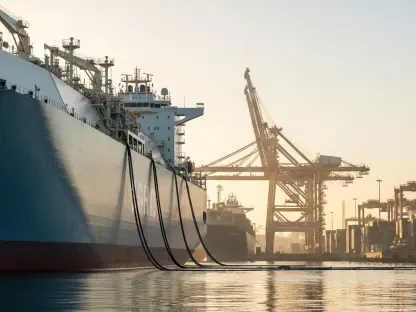The oil market is bracing for a turbulent year as analysts and investment banks adjust their forecasts in response to rising supply and economic uncertainties. With multiple factors influencing the trajectory of oil prices, industry experts are expecting a downward trend that could have significant implications for the global economy. As supply surges and economic conditions fluctuate, understanding the complex interplay between these elements becomes essential for predicting future trends in the oil market.
Analysts Lower Price Forecasts
Experts are predicting that oil prices will average in the low $70s this year, marking a decrease from earlier forecasts. Goldman Sachs has reduced its year-end forecast for Brent Crude by $5 to $71 per barrel, reflecting a more conservative outlook given current market conditions. Similarly, HSBC is anticipating a surplus of 200,000 barrels per day (bpd), which could contribute to lower average prices. These revisions underscore the widespread expectation among major financial institutions that the oil market is heading into a period of reduced prices.
Economic uncertainties have played a significant role in prompting these revisions. The impact of global trade policies and fluctuating economic growth projections has led analysts to adopt a less optimistic outlook for oil prices in the coming months. HSBC, in particular, has highlighted concerns over the potential for an economic slowdown triggered by trade tensions, which could further dampen oil demand. As a result, the combination of increased supply and economic unpredictability has set the stage for a cautious reassessment of oil price forecasts.
OPEC+ Supply Decisions
OPEC+ has announced plans to start adding barrels to the market soon, indicating an intention to increase supply in response to current market conditions. Despite the promise of higher production, OPEC+ maintains the flexibility to adjust its output based on evolving market dynamics. This adaptability is critical, as it allows the organization to respond to real-time demand fluctuations and other external factors that may impact the oil market.
Financial institutions such as Barclays and Wood Mackenzie have also adjusted their oil price forecasts, citing anticipated surpluses and increased supply as key reasons for their revisions. The interplay between OPEC+ decisions and supply dynamics is a focal point for analysts and investors, who are closely monitoring how these factors influence market stability. The ability of OPEC+ to manage supply in a way that balances market needs will be a crucial determinant of future oil price trends.
Impact of U.S. Trade Policies
The new U.S. administration’s trade and tariff policies have added layers of economic uncertainty, significantly affecting oil demand forecasts. Analysts have expressed concerns over the potential economic slowdowns fueled by escalating trade wars, which could dampen global oil demand. These trade policies introduce a level of unpredictability that complicates market forecasts and adds to the complexity of predicting future oil prices.
Trade policies and economic indicators are closely scrutinized by analysts who adjust their predictions based on these variables. As trade tensions heighten, the impact on the oil market becomes more pronounced, influencing everything from production strategies to pricing models. The broader economic repercussions of these policies are also a critical consideration, as they can have far-reaching effects on global demand for oil and other commodities.
Adjusted Economic Growth and Demand Outlook
Economic growth projections have been revised downward, impacting anticipated oil demand significantly. Barclays, for instance, has reduced its demand growth estimate by 510,000 bpd, which it attributes to economic uncertainties and weak high-frequency indicators. These adjustments reflect growing concerns over the ability of the global economy to sustain previous levels of growth, which in turn affects projections for oil consumption.
The demand outlook is heavily influenced by global economic performance, making it a crucial factor in forecasting oil prices. Weaker economic performance typically translates to subdued demand growth, contributing to predicted surpluses and lower prices. As economic indicators point to potential slowdowns, analysts are revising their models to account for these new realities, further reinforcing the expectation of a challenging year for the oil market.
Global Supply and Production Growth
Strong production growth, particularly from the U.S. and non-OPEC countries, is projected to outstrip demand growth. Wood Mackenzie’s analysis suggests that non-OPEC production will rise significantly, potentially outpacing demand growth by as much as 1.4 million bpd. This increase in production poses a challenge for maintaining price stability, as excess supply is likely to exert downward pressure on prices.
Increased supply from various producers around the world adds to the complexity of managing the oil market. As supply continues to exceed demand, the likelihood of sustained lower prices becomes more plausible. This dynamic underscores the importance of closely monitoring production levels and market responses to ensure that price volatility is kept in check.
Consensus Among Analysts
The oil market is preparing for a volatile year, with analysts and investment banks revising their predictions due to rising supply and economic uncertainties. Numerous factors are poised to affect oil price trends, and industry experts anticipate a downward movement that could have significant repercussions for the global economy. The expected increase in supply, coupled with fluctuating economic circumstances, makes it crucial to comprehend the intricate interactions among these factors to forecast future trends in the oil market accurately. As the industry faces these challenges, staying informed and adaptable is key for stakeholders looking to navigate the potential shifts in the market landscape. Consequently, understanding and predicting these trends become imperative for those involved in the oil industry to make informed decisions and strategize effectively amidst the prevailing unpredictability.









